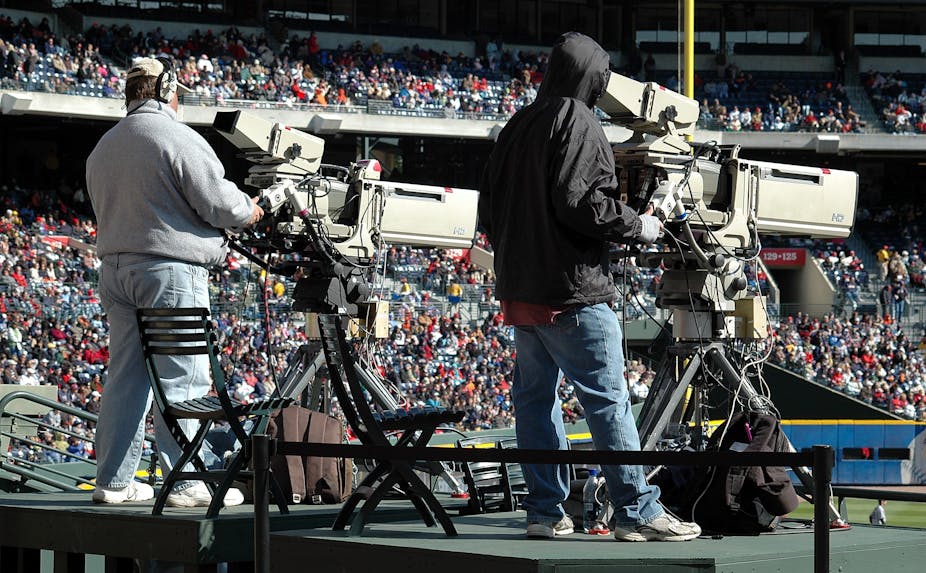The Australian men’s cricket team is playing a four-match test series in India. In this era of media cornucopia, you would expect live television action, radio commentary and photographic images to be available. But they are not.
Television broadcasting for the majority of households that do not subscribe to pay TV is restricted to snatched highlights on news and websites. Nobody is supplying live radio coverage and, absurdly, instead of vibrant still images, the main mastheads are supplying stick figure caricatures and cricketers’ heads grafted onto plastic figures.
Why has this happened?
The answers lie in the global power struggle between major sport and media organisations over controlling sport content and maximising revenue from it. With specific regard to cricket, the explanation resides in the rise of India as the game’s greatest force, and in its exacting of what I call “post-colonial revenge”.
Sport and media are very valuable, mutual properties. But the functional division between them is breaking down in the digital age, with sports organisations increasingly keen to monopolise their mediated output.
Premium sports such as cricket attract large, reliable audiences, leading television companies to pay substantial sums to acquire the rights to them. Although sports are increasing their own TV output, the main battleground is between commercial free-to-air and subscription TV for sports rights. In Australia and elsewhere, governments intervene to prevent the migration of sports events of “national importance and public significance” from free to pay-TV.
The current “anti-siphoning list” preventing pay-TV exclusivity does not include any Australian five-day matches abroad except the Ashes series with ye olde enemy England. Free TV does not have the rights to the India series, so cricket fans wanting to see it must pay Foxtel for the privilege or find a way around this arrangement through virtual private networks (VPNs), satellites or (questionably legal) online streaming.
At least overseas TV commentators are getting into the stadium. During the recent India-England series, a commercial dispute with the Board for Control for Cricket in India (BCCI) over additional fees for in-ground broadcast facilities saw commentary teams locked out of cricket grounds.
But surely there is always the radio, with the ABC reliably calling the play amid the noise of the crowds and AM static? Not this time. For the Australia-India series, the ABC refused to pay a sharply escalated BCCI surcharge and, as a consequence, the venerable commentator Jim Maxwell AM was denied media accreditation.
This should leave text-based print and online media supported by sport photography. But the BCCI (as it has before) sought to restrict accreditation to major picture agencies such as Getty Images. News Limited and Fairfax Media in Australia, and several international media organisations, then refused to accept and use BCCI-supplied images. Hence the shots of stick figures instead of real cricketers.
These conflicts between the BCCI and the media have left the current series in shadow. Negotiations to break the deadlock continue, but Indian cricket authorities press the point that the old days of Anglo-sphere sport and media domination of cricket have gone.
World cricket used to be run out of London by the Marylebone Cricket Club (MCC) and International Cricket Council (ICC). The former’s powers over the “laws of cricket” are now somewhat diminished, while the latter, long controlled by a coalition of imperial centre and white-settler ex-colonies, is now under the influence of an India-led bloc. It moved to Dubai in 2005.
The BCCI and Indian representatives on ICC committees seldom fail to remind other cricket nations that India generates approaching eight out of every ten “legal” dollars circulating around world cricket. It runs the Indian Premier League (IPL) which, as one of the world’s richest sporting leagues, is a honeypot for players from all around the world (except Pakistan, whose players are never picked in IPL auctions for political reasons).
Indian cricket is anxious to assert that it will no longer defer to patrician white authority, a discourse deployed in its manoeuvring to block John Howard’s 2010 nomination as ICC Vice-President. This new-found feistiness was evident earlier during the infamous 2008 “Monkeygate” affair, when India threatened to abandon Australia mid-tour over the disciplining of spinner Harbhajan Singh for allegedly calling the black Australian player Andrew Symonds “a monkey”.
A compromise was found and the tour continued, but the point was made about who is in charge of cricket’s new order. The more aggressive, high-handed actions of the BCCI over media access (pre-figured, in fact, by Cricket Australia’s own journalist lockout in the 2007 home series against Sri Lanka) are predictable power plays in a multi-billion dollar global game. Simultaneously, though, the taste of post-colonial revenge is sweet.
If it all goes too far, unbridled Indian supremacy will undermine the health of world cricket. For now in Australia, though, it just means no crackly radio or action pictures from India.

